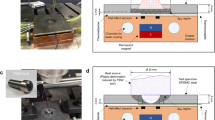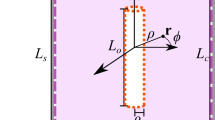Abstract
SLOWLY changing magnetic fields have usually been measured by means of search coils with iron or mumetal cores, connected either to fluxmeters or to galvanometers. In this communication the term ‘coiled rod’ is employed and means a straight ferromagnetic rod about which a detector-coil is wound. The sensitivity or detecting power of the coiled rod is usually defined as the total number of flux linkages of the winding produced in the coiled rod by a spatially uniform magnetic field of one oersted and is measured in Maxwell-turns per oersted. The advantage of mumetal over iron for the core of the coiled rod has been its high permeability in low magnetic fields, low electrical losses and low coercive force. Any further increase in sensitivity of coiled rods has been obtained either by lengthening the rod and so reducing its demagnetizing factor or by winding on more turns—the latter case being accompanied by a rapid increase in inductance and by increased resistance unless the diameter of the wire in the coil is correspondingly increased, which in turn affects the overall diameter.
This is a preview of subscription content, access via your institution
Access options
Subscribe to this journal
Receive 51 print issues and online access
$199.00 per year
only $3.90 per issue
Buy this article
- Purchase on Springer Link
- Instant access to full article PDF
Prices may be subject to local taxes which are calculated during checkout
Similar content being viewed by others
Author information
Authors and Affiliations
Rights and permissions
About this article
Cite this article
WALKER, D. Improvement in the Magnetic Detecting Power of Iron-cored Search Coils. Nature 183, 173–174 (1959). https://doi.org/10.1038/183173b0
Issue Date:
DOI: https://doi.org/10.1038/183173b0
Comments
By submitting a comment you agree to abide by our Terms and Community Guidelines. If you find something abusive or that does not comply with our terms or guidelines please flag it as inappropriate.



